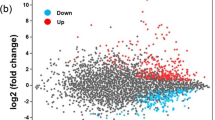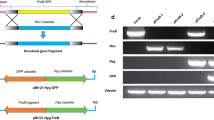Abstract
During infection, the phytopathogenic enterobacterium Dickeya dadantii has to cope with iron-limiting conditions and the production of reactive oxygen species by plant cells. A tight control of the bacterial intracellular iron content is necessary for full virulence of D. dadantii: previous studies have shown that the ferritin FtnA and the bacterioferrtin Bfr, devoted to iron storage, contribute differentially to the virulence of this species. In this work, we investigated the role of the Dps miniferritin in iron homeostasis in D. dadantii. We constructed a Dps-deficient mutant by reverse genetics. This mutant grew like the wild-type stain under iron starvation and showed no decreased iron content. However, the dps mutant displayed an increased sensitivity to hydrogen peroxide in comparison to the wild-type strain. This hydrogen peroxide susceptibility only occurs when bacteria are in the stationary phase. Unlike the bfr and the ftnA mutants, the dps mutant is not affected in its pathogenicity on host plants. The dps gene expression is induced at the stationary phase of growth. The Sigma S transcriptional factor is necessary for this control. Furthermore, dps expression is positively regulated by the oxidative stress response regulator OxyR during the exponential growth phase, after hydrogen peroxide treatment. These results indicate that the Dps miniferritin from D. dadantii has a minor role in iron homeostasis, but is important in conferring tolerance to hydrogen peroxide and for survival of cells that enter the stationary phase of growth.









Similar content being viewed by others
References
Almirón M, Link AJ, Furlong D, Kolter R (1992) A novel DNA-binding protein with regulatory and protective roles in starved Escherichia coli. Genes Dev 6:2646–2654
Altuvia S, Almirón M, Huisman G, Kolter R, Storz G (1994) The dps promoter is activated by OxyR during growth and by IHF and sigma S in stationary phase. Mol Microbiol 13:265–272
Andrews SC (2010) The Ferritin-like superfamily: evolution of the biological iron storeman from a rubrerythrin-like ancestor. Biochim Biophys Acta 1800:691–705
Boughammoura A, Matzanke BF, Böttger L, Reverchon S, Lesuisse E, Expert D, Franza T (2008) Differential role of ferritins in iron metabolism and virulence of the plant-pathogenic bacterium Erwinia chrysanthemi 3937. J Bacteriol 190:1518–1530
Calhoun LN, Kwon YM (2010) Structure, function and regulation of the DNA-binding protein Dps and its role in acid and oxidative stress resistance in Escherichia coli: a review. J Appl Microbiol 110:375–386
Ceci P, Ilari A, Falvo E, Chiancone E (2003) The Dps protein of Agrobacterium tumefaciens does not bind to DNA but protects it toward oxidative cleavage: X-ray crystal structure, iron binding, and hydroxyl-radical scavenging properties. J Biol Chem 278:20319–20326
Ceci P, Di Cecca G, Falconi M, Oteri F, Zamparelli C, Chiancone E (2011) Effect of the charge distribution along the “ferritin-like” pores of the proteins from the Dps family on the iron incorporation process. J Biol Inorg Chem 16:869–880
Chiancone E, Ceci P (2010) The multifaceted capacity of Dps proteins to combat bacterial stress conditions: detoxification of iron and hydrogen peroxide and DNA binding. Biochim Biophys Acta 1800:798–805
Choi SH, Baumler DJ, Kaspar CW (2000) Contribution of dps to acid stress tolerance and o oxidative stress tolerance in Escherichia coli O157:H7. Appl Environ Microbiol 66:3911–3916
Colburn-Clifford JM, Scherf JM, Allen C (2010) Ralstonia solanacearum Dps contributes to oxidative stress tolerance and to colonization of and virulence on tomato plants. Appl Environ Microbiol 76:7392–7399
Expert D, Boughammoura A, Franza T (2008) Siderophore-controlled iron assimilation in the enterobacterium Erwinia chrysanthemi: evidence for the involvement of bacterioferritin and the Suf iron-sulfur cluster assembly machinery. J Biol Chem 283:36564–36572
Fagard M, Dellagi A, Roux C, Périno C, Rigault M, Boucher V, Shevchik VE, Expert D (2007) Arabidopsis thaliana expresses multiple lines od defense to counter-attack Erwinia chrysanthemi. Mol Plant-Microbe Interact 20:794–805
Ferguson GP, Creighton RI, Nikolaev Y, Booth IR (1998) Importance of RpoS and Dps in survival of exposure of both exponential- and stationary-phase Escherichia coli cells to the electrophile N-ethylmaleimide. J Bacteriol 180:1030–1036
Franza T, Sauvage C, Expert D (1999) Iron regulation and pathogenicity in Erwinia chrysanthemi strain 3937: role of the Fur repressor protein. Mol Plant Microbe Interact 12:119–129
Franza T, Michaud-Soret I, Piquerel P, Expert D (2002) Coupling of iron assimilation and pectinolysis in Erwinia chrysanthemi 3937. Mol Plant Microbe Interact 15:1181–1191
Franza T, Mahé B, Expert D (2005) Erwinia chrysanthemi requires a second iron transport route dependent of the siderophore achromobactin for extracellular growth and plant infection. Mol Microbiol 55:261–275
Glasner JD, Yang CH, Reverchon S, Hugouvieux-Cotte-Pattat N, Condemine G, Bohin JP, Van Gijsegem F, Yang S, Franza T, Expert D, Plunkett G et al (2011) Genome sequence of the plant-pathogenic bacterium Dickeya dadantii 3937. J Bacteriol 193:2076–2077
Haikarainen T, Papageorgiou AC (2010) Dps-like proteins: structural and functional insights into a versatile protein family. Cell Mol Life Sci 67:341–351
Halsey TA, Vazquez-Torres A, Gravdahl DJ, Fang FC, Libby SJ (2004) The ferritin-like Dps protein is required for Salmonella enterica serovar Typhimurium oxidative stress resistance and virulence. Infect Immun 72:1155–1158
Jeong KC, Hung KF, Baumler DJ, Byrd JJ, Kaspar CW (2008) Acid stress damage of DNA is prevented by Dps binding in Escherichia coli O157:H7. BMC Microbiol 8:181
Kepseu WD, Sepulchre JA, Reverchon S, Nasser W (2010) Toward a quantitative modeling of the synthesis of the pectate lyases, essential virulence factors in Dickeya dadantii. J Biol Chem 285:8565–28576
Le Brun NE, Crow A, Murphy ME, Mauk AG, Moore GR (2010) Iron core mineralisation in prokaryotic ferritins. Biochim Biophys Acta 1800:732–744
Li X, Pal U, Ramamoorthi N, Liu X, Desrosiers DC, Eggers CH, Anderson JF, Radolf JD, Fikrig E (2007) The Lyme disease agent Borrelia burgdorferi requires BB0690, a Dps homologue, to persist within ticks. Mol Microbiol 63:694–710
Malone AS, Chung YK, Yousef AE (2006) Genes of Escherichia coli O157: H7 that are involved in high-pressure resistance. Appl Environ Microbiol 72:2661–2671
Martinez A, Kolter R (1997) Protection of DNA during oxidative stress by the nonspecific DNA- binding protein Dps. J Bacteriol 179:5188–5194
Miguel E, Poza-Carrión C, López-Solanilla E, Aguilar I, Llama-Palacios A, García-Olmedo F, Rodríguez-Palenzuela P (2000) Evidence against a direct antimicrobial role of H2O2 in the infection of plants by Erwinia chrysanthemi. Mol Plant Microbe Interact 13:421–429
Münzinger M, Budzikiewicz H, Expert D, Enard C, Meyer JM (2000) Achromobactin, a new citrate siderophore of Erwinia chrysanthemi. Z Naturforsch C 55:328–332
Murdoch L, Corbel JC, Reis D, Bertheau Y, Vian B (1999) Differential cell wall degradation by Erwinia chrysanthemi in petiole of Saintpaulia ionantha. Protoplasma 210:59–74
Nachin L, El Hassouni M, Loiseau L, Expert D, Barras F (2001) SoxR-dependent response to oxidative stress and virulence of Erwinia chrysanthemi: the key role of SufC, an orphan ABC ATPase. Mol Microbiol 39:960–972
Nair S, Finkel SE (2004) Dps protects cells against multiple stresses during stationary phase. J Bacteriol 186:4192–4198
Persmark M, Expert D, Neilands JB (1989) Isolation, characterization and synthesis of chrysobactin, a compound with a siderophore activity from Erwinia chrysanthemi. J Biol Chem 264:3187–3193
Polenghi A, Bossi F, Fischetti F, Durigutto P, Cabrelle A, Tamassia N, Cassatella MA, Montecucco C, Tedesco F, de Bernard M (2007) The neutrophil-activating protein of Helicobacter pylori crosses endothelia to promote neutrophil adhesion in vivo. J Immunol 178:1312–1320
Prentki P, Krisch HM (1984) In vitro insertional mutagenesis with a selectable DNA fragment. Gene 29:303–313
Résibois A, Colet M, Faelen M, Schoonejans E, Toussaint A (1984) Phi-EC2 a new generalized transducing phage of Erwinia chrysanthemi. Virology 137:102–112
Sambrook J, Fritsch EF, Maniatis T (1989) Molecular cloning: a laboratory manual, 2nd edn. Cold Spring Harbor Press, New York
Santos R, Franza T, Laporte ML, Sauvage C, Touati D, Expert D (2001) Essential role of superoxide dismutase on the pathogenicity of Erwinia chrysanthemi strain 3937. Mol Plant Microbe Interact 14:758–767
Sauvage C, Expert D (1994) Differential regulation by iron of Erwinia chrysanthemi pectate lyases: pathogenicity of iron transport regulatory cbr mutants. Mol Plant-Microbe Interact 7:71–77
Thieme D, Grass GJ (2010) The Dps protein of Escherichia coli is involved in copper homeostasis. Microbiol Res 165:108–115
Toledano MB, Kullik I, Trinh F, Baird PT, Schneider TD, Storz G (1994) Redox-dependent shift of OxyR-DNA contacts along an extended DNA-binding site: a mechanism for differential promoter selection. Cell 78:897–909
Ueshima J, Shoji M, Ratnayake DB, Abe K, Yoshida S, Yamamoto K, Nakayama K (2003) Purification, gene cloning, gene expression, and mutants of Dps from the obligate anaerobe Porphyromonas gingivalis. Infect Immun 71:1170–1178
Wolf SG, Frenkiel D, Arad T, Finkel SE, Kolter R, Minsky A (1999) DNA protection by stress- induced biocrystallization. Nature 400:83–85
Yang S, Peng Q, Zhang Q, Yi X, Choi CJ, Reedy RM, Charkowski AO, Yang CH (2008) Dynamic regulation of GacA in type III secretion, pectinase gene expression, pellicle formation, and pathogenicity of Dickeya dadantii (Erwinia chrysanthemi 3937). Mol Plant Microbe Interact 21:133–142
Zhao G, Ceci P, Ilari A, Giangiacomo L, Laue TM, Chiancone E, Chasteen ND (2002) Iron and hydrogen peroxide detoxification properties of DNA-binding protein from starved cells. A ferritin-like DNA-binding protein of Escherichia coli. J Biol Chem 277:27689–27696
Zheng M, Wang X, Doan B, Lewis KA, Schneider TD, Storz G (2001) Computation-directed identification of OxyR DNA binding sites in Escherichia coli. J Bacteriol 183:4571–4579
Acknowledgments
We thank Professor Pablo Rodríguez-Palenzuela for the generous gift of the D. dadantii oxyR mutant. We are indebted to the Institut National de la Recherche Agronomique for financial support. A. Boughammoura was supported by a doctoral fellowship from the Ministère de l’Education Nationale, de l’Enseignement Supérieur et de la Recherche.
Author information
Authors and Affiliations
Corresponding author
Additional information
Dominique Expert is a Researcher from the Centre National de la Recherche Scientifique (CNRS).
Rights and permissions
About this article
Cite this article
Boughammoura, A., Expert, D. & Franza, T. Role of the Dickeya dadantii Dps protein. Biometals 25, 423–433 (2012). https://doi.org/10.1007/s10534-011-9515-5
Received:
Accepted:
Published:
Issue Date:
DOI: https://doi.org/10.1007/s10534-011-9515-5




